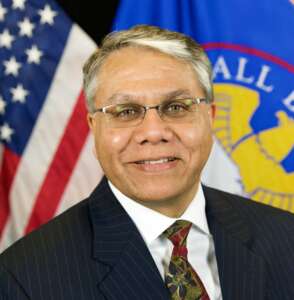Exclusive
USCIS deputy to become TSA CIO
Justice Department’s Executive Office for Immigration Review names Sanjay Gupta, the former SBA CTO, as its new CIO.
Russ Roberts, the Transportation Security Administration’s chief information officer, stayed on in federal service a little longer than expected.
Roberts, who announced in December he would leave at the end of the 2021, delayed his retirement for a few months but now is ready to move on.
A TSA spokesman has confirmed that the agency has chosen Yemi Oshinnaiye, the deputy CIO at the U.S. Citizenship and Immigration Services (USCIS), as its new permanent CIO.

Roberts will retire at the end of May and Oshinnaiye will start in early May to ensure there is an easy transition.
Oshinnaiye has been the deputy CIO at USCIS since March 2019, but worked at DHS previously from 2012 to 2017. He went into the private sector for a short stint before returning to USCIS.
During his tenure at USCIS, Oshinnaiye helped lead the effort to consolidate and improve how the agency uses cloud services.
In 2021, USCIS launched an effort called “clean my cloud.”
“There are so many cloud services at some point, we’re going to be a plethora of different clouds integrating and underlying our network. We took a step back and took a look at that and now anytime we move or build a new workload, we’re looking at what’s in the cloud already. That has enabled us to optimize. Now we have this thing where we’re looking at, our CTO called it ‘clean my cloud.’ So we’re looking at it every month. When you put something in cloud, if you haven’t done something to optimize it, we kind of call you out. So we gamified it a little bit,” Oshinnaiye said during a March 2021 panel.
That optimization effort led to savings that USCIS can put into other modernization initiatives.
Oshinnaiye said using virtual machines and automation are some of the ways his office increased the value of technology while reducing complexity and costs.
In coming to TSA, Oshinnaiye inherits a huge organization in the midst of a technology transformation.
Research firm Deltek estimated that TSA’s IT budget request for fiscal 2023 would be $967 million. This is less than the $1 billion IT budget it received in this year, but $161 million more than it received in 2021.
One of TSA’s big requests for 2023 is enterprise cybersecurity. The agency asked for $23.5 million to support 17 employees.
“This funding will enable early detection to dramatically improve the cybersecurity of TSA networks and provide a better ability to protect TSA’s sensitive data,” the DHS budget request stated. “In 2021, TSA investigated 2,412 cases in the calendar year, which subsequently yielded 84 confirmed incidents. A significant number of these cases (over 72%) were sourced from security logging, which captured unauthorized/malicious activity in TSA’s networks. TSA recognizes that to keep pace with today’s dynamic and increasingly sophisticated cyber threat environment, decisive steps are necessary to increase visibility into threats while adopting security best practices for logging and performing threat remediation via enhanced investigation tactics and increased resources. In addition to implementing one of TSA’s key strategic priorities, these funds support requirements described in Executive Order 14028.”
Along with TSA, the Justice Department’s Executive Office for Immigration Review has a new CIO, and a familiar face at that.
Sanjay Gupta joined EOIR in March after more than five years the Small Business Administration’s chief technology officer.

Gupta became at least the fourth former SBA technology executive to move into a larger role over the last 18 months. He joins Guy Cavallo, who is now the CIO at the Office of Personnel Management, Nagesh Rao, who is now the CIO at the Commerce Department’s Bureau of Industry and Security, and of course Maria Roat, the former SBA CIO and recently retired deputy federal CIO, in leaving the agency for bigger opportunities.
Gupta helped lead the SBA’s technology transformation, moving applications and systems to the cloud, testing out leading edge cybersecurity tools and embracing more digital services delivery.
In joining the Executive Office for Immigration Review, Gupta enters an entirely new sector where he will be supporting lawyers and judges who are adjudicating immigration cases. EOIR conducts immigration court proceedings, appellate reviews and administrative hearings.
EOIR’s IT organization has four directorates:
- Chief architect
- Operations services
- Governance, planning and support
- Software development
In case you missed these CIOs on the move
There has been a lot of other agency CIOs coming and going over the last few months. Here are some others that you may have missed.
FEMA CIO Lytwaive Hutchinson is retiring after 41 years of federal service.
Hutchinson joined FEMA in April 2019 after spending her entire career with the Defense Department. She served 21 years in the Army and then spent 17 years working in various senior leadership roles in the DoD CIO’s office.
The CIA named La’Naia Jones as its new CIO and the director of the Information Technology Enterprise (ITE) within the Directorate of Digital Innovation at the CIA in February.
She took over for Juliane Gallina, who moved to a new role in February. Gallina is now the deputy director of the CIA’s Directorate of Digital Innovation. Jones came to the CIA after serving as the deputy CIO at the National Security Agency for the past year. She also served as the deputy CIO of the intelligence community in the Office of the Director of National Intelligence for two years.
Finally also in March, Director of National Intelligence Avril Haines selected Adele Merritt to serve as CIO for the Intelligence Community.
Merritt was most recently program manager at DreamPort, a cyber innovation nonprofit created by U.S. Cyber Command.
Michael Waschull had been acting IC CIO for the past year. Haines said he would stay on as Merritt’s deputy.
Two other job openings
The Office of Justice Programs finally put out the job announcement to fill its vacant CIO position.
Brian McGrath, who had been CIO at OJP for six years, retired in October.
OJP said in its job announcement that the CIO “[h]as full responsibility for the oversight and management of all OCIO functional areas, including enterprise architecture, application development, infrastructure and engineering, cybersecurity, policy and planning and project management. Ensures the implementation of an integrated enterprise through coordination of resources across the agency and collaboration with other components to deliver a fully integrated capability that supports internal and external customers. Develops performance metrics and data to determine goals and decides methods, plans and schedules work, adjusts staffing and procedures to allocate resources, sets and adjusts priority, and assigns work based on priority.”
The application deadline was April 15.
The National Highway Traffic Safety Administration (NHTSA) is looking to hire a chief data officer.
NHTSA outlined seven roles the CDO will fill, including “developing and continually updating a comprehensive data and information product portfolio strategy, and developing and implementing a data services strategy to maximize use of NHTSA data for internal users, including data warehouses, data sets (e.g. MAX data), business intelligence tools, utilizing DOT shared services offerings whenever possible and practical.”
Applications for the position are due by May 5.
Finally, Oki Mek, the former chief artificial intelligence officer and chief technology officer for the Department of Health and Human Services, is back after a short time off.
Mek announced he joined Equideum Health as its chief information security officer. The company says Mek ensures that Equideum Health’s critical infrastructure is protected through cybersecurity capabilities and uses artificial intelligence (AI) and blockchain technologies.
Copyright © 2025 Federal News Network. All rights reserved. This website is not intended for users located within the European Economic Area.
Jason Miller is executive editor of Federal News Network and directs news coverage on the people, policy and programs of the federal government.
Follow @jmillerWFED







